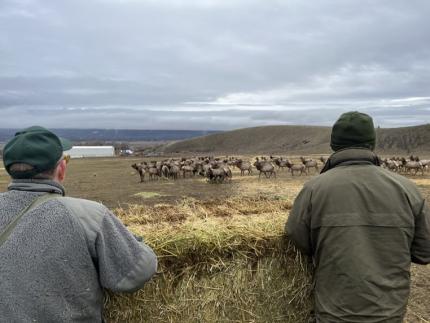Managing Wildlife Populations
Lynx Monitoring: Wildlife Biologists Prince and Turnock participated in two meetings about lynx monitoring in the Kettle Mountains of northeast Washington. A large effort for monitoring lynx occupancy and snowshoe hare abundance (still in the works) within the Kettles may begin this summer depending on funding and staff availability. Entities involved include the Confederated Tribes of the Colville Reservation, U.S. Forest Service, Washington Department of Fish and Wildlife (WDFW), U.S. Fish and Wildlife Service, Washington State University, and Conservation Northwest.
Elk Damage: Natural Resource Technician Nizer and Wildlife Conflict Specialist Harris met with two producers in northeast Whitman County that were having elk damage on their crops. Nizer talked about the access program and how that could help mitigate the elk damage. Harris talked about the Damage Prevention Cooperative Agreement (DPCA) and how it works well with an access agreement. Both producers were interested in the program. If they agree to a contract, it will add about 1,000 acres in the Hunt by Reservation Program and 300 acres in the Hunt by Written Permission Program for elk and pheasant hunting access. Nizer will follow up with landowners to see if they want a contract worked up.
Elk: Biologist Brinkman and other biologists from Region 1 traveled to an elk feeding site outside of Ellensburg to participate in immobilization training with Wildlife Veterinarian Mansfield and other WDFW staff members that have extensive experience in capturing ungulates. The purpose of this training was to practice working through the department capture protocols and datasheet that will be used on moose captures next week.


Providing Recreation Opportunities
Hunter Contact: Wildlife Conflict Specialist Wade was contacted by a quality elk tag holder. Wade assisted with locating potential areas to hunt during the 2023 muzzleloader season. The hunter reported that he sent teeth from his elk to a lab in Montana to be aged and wanted to share the results. Wade also answered several questions for the hunter regarding potential hunts for the coming year.
Providing Conflict Prevention and Education
Radio Activated Guard Box (RAG) Check: Wildlife Conflict Specialist Wade traveled to the Grande Ronde to check on the RAG box that was deployed last week, in a feedlot that has had recent wolf activity. The RAG box was functioning properly, and all cattle observed were calm and feeding.

Deer Damage: Wildlife Conflict Specialist Kolb received a complaint of deer damage to a cherry orchard in Walla Walla County. A site visit was conducted, and damage permits were issued in an effort to mitigate further damage.
Conserving Natural Landscapes
W.T. Wooten Wildlife Area – Tree Planting: Wildlife Area Manger Dingman and Natural Resource Technician Tritt worked on planting ponderosa pine trees at the Rainbow Lake spoils site. The trees will replace the trees that were removed from the dam on the north end of Rainbow Lake. Two of the staff members at the Tucannon Fish Hatchery stopped by and helped plant the last 12 trees.
Channeled Scablands Habitat Conservation - Outreach Kick-off Meeting: Wildlife Area Finch attended a meeting regarding the Channel Scablands habitat conservation. The purpose for the meeting was to discuss the next steps for wetland habitat conservation after the Waterfowl Spring Migration Survey and Report project in the eastern Washington Channeled Scablands. Everyone that attended the meeting was trying to come up with ideas for how to advertise conservation to private landowners. They want it to be appealing for landowners to develop their property for habitat conservation for waterfowl migration.
Providing Education and Outreach
Bear Outreach and Education: Biologists Lowe and Brinkman attended the second Grizzly Bear Information, Education and Outreach Summit in Coeur d’Alene Idaho. The workshop included 120 participants from several state and federal agencies, two provinces, non-profits, businesses, county representatives, and community members.
Public School Visit: Sherman Creek Wildlife Area Assistant Manager Palmer conducted an annual visit to the Kettle Falls Elementary School, to teach 4th grade students about wildlife interactions. The entire grade of about 50 kids was broken up into four groups: Eagle, Wolf, Cougar, and Deer, where they learned about their animal’s life history.

4th Grade Animal Experts: Wildlife Biologists Prince, Turnock, Bennett, and Palmer served as experts to 4th graders at Kettle Falls Elementary School. They shared information and answered questions about bald eagles, cougars, white-tailed deer, and wolves.
Waikiki Springs Eagle Scout Project: Access Manager Dziekan met with a boy scout to sign off on a project proposition so that the scout troop can begin working on it. This project has been in the works for some time now. With Dziekan’s signature agreeing to the project, the boy scout will begin building and installing an informational kiosk at Waikiki Springs Wildlife Area. This kiosk will be installed at the lower portion of the wildlife area to compliment the kiosk at the trail head, which was also an Eagle Scout project. The boy scout has the funding secured to purchase the materials. Once the scout has acquired everything that is needed, Dziekan will schedule a time for the scout and a trusted adult, since the scout is under 18, to meet at the WDFW Region 1 shop and use the workspace and tools to build this kiosk.
Conducting Business Operations and Policy
Equipment Maintenance: On Feb. 1, Sherman Creek Wildlife Area Assistant Manager Palmer turned over two old snowmobiles to the gentleman who bought them from state surplus. Palmer also changed the oil filter on one of the newer snowmobiles assigned to Sherman Creek Wildlife Area.
